bar Alfa Romeo Giulietta 2012 Owner handbook (in English)
[x] Cancel search | Manufacturer: ALFA ROMEO, Model Year: 2012, Model line: Giulietta, Model: Alfa Romeo Giulietta 2012Pages: 297, PDF Size: 9.37 MB
Page 2 of 297
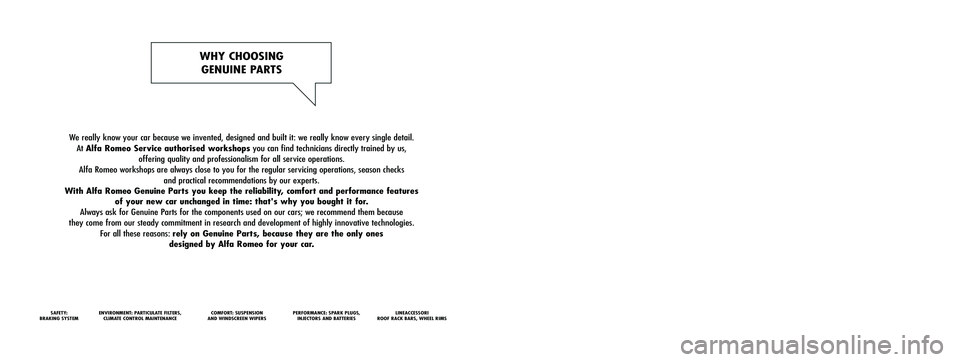
We really know your car because we invented, designed and built it: we really know every single detail.
At Alfa Romeo Service authorised workshopsyou can find technicians directly trained by us,
offering quality and professionalism for all service operations.
Alfa Romeo workshops are always close to you for the regular servicing operations, season checks
and practical recommendations by our experts.
With Alfa Romeo Genuine Parts you keep the reliability, comfort and performance features
of your new car unchanged in time: that's why you bought it for.
Always ask for Genuine Parts for the components used on our cars; we recommend them because
they come from our steady commitment in research and development of highly innovative technologies.
For all these reasons: rely on Genuine Parts, because they are the only ones
designed by Alfa Romeo for your car.
SAFETY:
BRAKING SYSTEMENVIRONMENT: PARTICULATE FILTERS,
CLIMATE CONTROL MAINTENANCECOMFORT: SUSPENSION
AND WINDSCREEN WIPERS PERFORMANCE: SPARK PLUGS,
INJECTORS AND BATTERIESLINEACCESSORI
ROOF RACK BARS, WHEEL RIMS
WHY CHOOSING
GENUINE PARTS
Cop Alfa Giulietta GB:Alfa 159 cop. LUM GB 15-09-2011 15:08 Pagina 2
Page 37 of 297
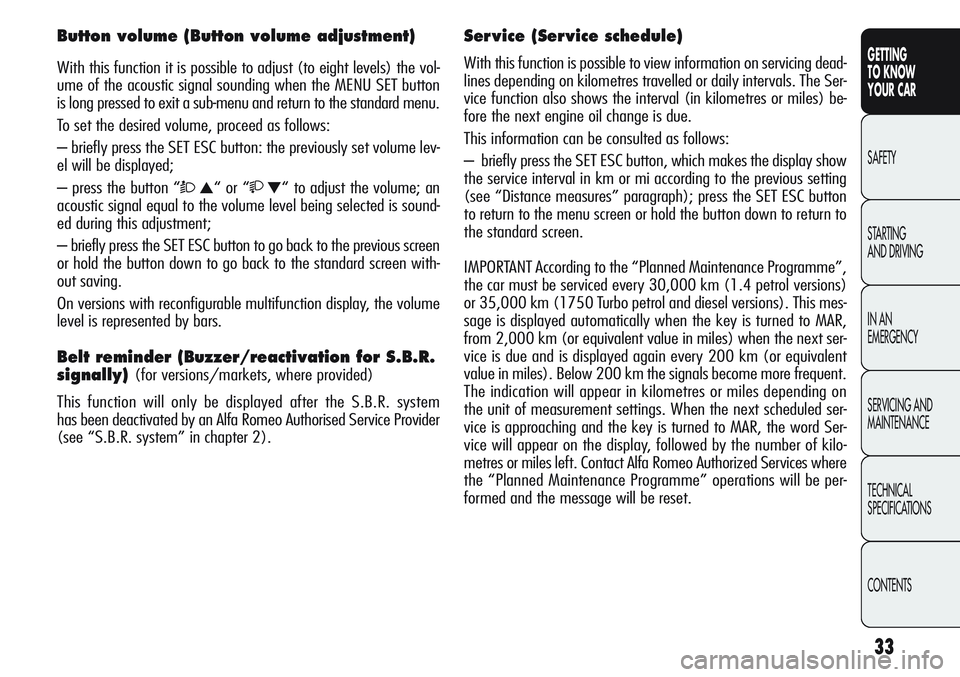
33
GETTING
TO KNOW
YOUR CAR
SAFETY
STARTING
AND DRIVING
IN AN
EMERGENCY
SERVICING AND
MAINTENANCE
TECHNICAL
SPECIFICATIONS
CONTENTS
Button volume (Button volume adjustment)
With this function it is possible to adjust (to eight levels) the vol-
ume of the acoustic signal sounding when the MENU SET button
is long pressed to exit a sub-menu and return to the standard menu.
To set the desired volume, proceed as follows:
– briefly press the SET ESC button: the previously set volume lev-
el will be displayed;
– press the button “
Ò▲“ or “▼“ to adjust the volume; an
acoustic signal equal to the volume level being selected is sound-
ed during this adjustment;
– briefly press the SET ESC button to go back to the previous screen
or hold the button down to go back to the standard screen with-
out saving.
On versions with reconfigurable multifunction display, the volume
level is represented by bars.
Belt reminder (Buzzer/reactivation for S.B.R.
signally)
(for versions/markets, where provided)
This function will only be displayed after the S.B.R. system
has been deactivated by an Alfa Romeo Authorised Service Provider
(see “S.B.R. system” in chapter 2).
Ser vice (Ser vice schedule)
With this function is possible to view information on servicing dead-
lines depending on kilometres travelled or daily intervals. The Ser-
vice function also shows the interval (in kilometres or miles) be-
fore the next engine oil change is due.
This information can be consulted as follows:
– briefly press the SET ESC button, which makes the display show
the service interval in km or mi according to the previous setting
(see “Distance measures” paragraph); press the SET ESC button
to return to the menu screen or hold the button down to return to
the standard screen.
IMPORTANT According to the “Planned Maintenance Programme”,
the car must be serviced every 30,000 km (1.4 petrol versions)
or 35,000 km (1750 Turbo petrol and diesel versions). This mes-
sage is displayed automatically when the key is turned to MAR,
from 2,000 km (or equivalent value in miles) when the next ser-
vice is due and is displayed again every 200 km (or equivalent
value in miles). Below 200 km the signals become more frequent.
The indication will appear in kilometres or miles depending on
the unit of measurement settings. When the next scheduled ser-
vice is approaching and the key is turned to MAR, the word Ser-
vice will appear on the display, followed by the number of kilo-
metres or miles left. Contact Alfa Romeo Authorized Services where
the “Planned Maintenance Programme” operations will be per-
formed and the message will be reset.
Page 55 of 297

51
GETTING
TO KNOW
YOUR CAR
SAFETY
STARTING
AND DRIVING
IN AN
EMERGENCY
SERVICING AND
MAINTENANCE
TECHNICAL
SPECIFICATIONS
CONTENTS
Heated seats
(for versions/markets, where provided)
With the key turned to MAR, press A button fig. 23 to switch the
function on/off. When the function is enabled, the LED on the but-
ton turns on.
Electric lumbar adjustment
(for versions/markets where provided)
With the key turned to MAR, press B button fig. 23 to switch the
function on/off. When the function is enabled, the LED on the but-
ton turns on.
fig. 23A0K0213m
ELECTRICALLY ADJUSTABLE FRONT SEATS
fig. 24
(for versions/markets, where provided)
The following controls are provided for adjusting the seats:
Multifunction A control:
❍front seat height adjustment (seat vertical movement);
❍seat lengthwise movement
B: Backrest angle and lumbar adjustment;
C: Driver’s seat position storing buttons.
fig. 24A0K0214m
Page 150 of 297

146
GETTING
TO KNOW
YOUR CAR
SAFETY
STARTING
AND DRIVING
IN AN
EMERGENCY
SERVICING AND
MAINTENANCE
TECHNICAL
SPECIFICATIONS
CONTENTS
FRONT AIRBAGS
The car is provided with multistage front air bags (“Smart bag”)
for driver and passenger.
“SMART BAG” SYSTEM
(MULTISTAGE FRONT AIR BAGS)
The front driver/passenger air bags are designed to protect occu-
pants in the event of head-on crashes of medium-high severity,
by placing the bag between the occupant and the steering wheel
or dashboard.
Front air bags are designed to protect car’s occupants in front crash-
es and therefore non-activation in other types of collisions (side col-
lisions, rear shunts, roll-overs, etc.) is not a system malfunction.
The air bag do not replace, but rather complement the use of seat
belts, which should always be worn. In the event of an impact,
someone not wearing a seat belt could move forward and come
into contact with a bag which is still in the opening phase. The pro-
tection offered by the bag is reduced in such a case.
Front air bags may not be activated in the following situations:
❍front collisions against highly deformable objects not affect-
ing the front surface of the car (e.g. bumper collision against
guard rail, etc.);
❍car penetration under other vehicles or protective barriers (e.g.
trucks or guard rails);
in these instances they could not provide any additional protec-
tion compared with seat belts, so their deployment would not be
useful. In these cases, non-deployment of the airbag does not
necessarily indicate a system malfunction.
FRONT AIR BAG ON DRIVER’S SIDE fig. 106
This is located in a dedicated compartment in the centre of the steer-
ing wheel.
Do not apply stickers or other objects to the steer-
ing wheel, passenger side air bag cover or upper
side upholstery. Do not place objects on the pas-
senger side dashboard because these could interfere with
the correct opening of the air bag and cause severe injury
to occupants.
fig. 106A0K0080m
Always drive with your hands on the steering wheel
rim so that the air bag can inflate freely if need-
ed. Do not drive with your body bent forward.
Keep your back straight against the backrest.
Page 163 of 297
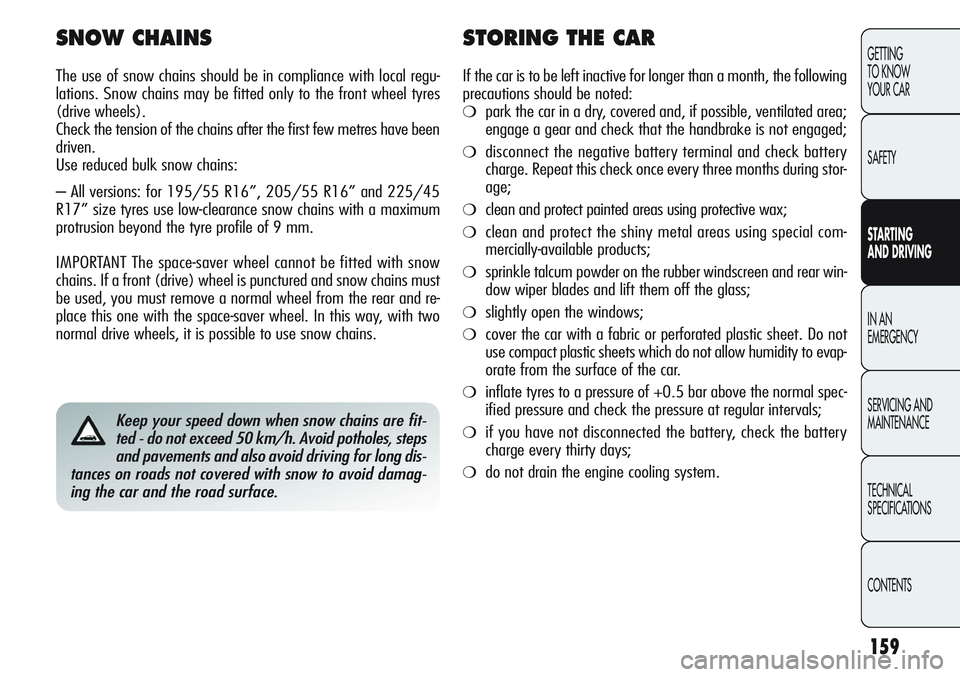
159
GETTING
TO KNOW
YOUR CAR
SAFETY
STARTING
AND DRIVING
IN AN
EMERGENCY
SERVICING AND
MAINTENANCE
TECHNICAL
SPECIFICATIONS
CONTENTS
Keep your speed down when snow chains are fit-
ted - do not exceed 50 km/h. Avoid potholes, steps
and pavements and also avoid driving for long dis-
tances on roads not covered with snow to avoid damag-
ing the car and the road surface.
SNOW CHAINS
The use of snow chains should be in compliance with local regu-
lations. Snow chains may be fitted only to the front wheel tyres
(drive wheels).
Check the tension of the chains after the first few metres have been
driven.
Use reduced bulk snow chains:
– All versions: for 195/55 R16”, 205/55 R16” and 225/45
R17” size tyres use low-clearance snow chains with a maximum
protrusion beyond the tyre profile of 9 mm.
IMPORTANT The space-saver wheel cannot be fitted with snow
chains. If a front (drive) wheel is punctured and snow chains must
be used, you must remove a normal wheel from the rear and re-
place this one with the space-saver wheel. In this way, with two
normal drive wheels, it is possible to use snow chains.
STORING THE CAR
If the car is to be left inactive for longer than a month, the following
precautions should be noted:
❍park the car in a dry, covered and, if possible, ventilated area;
engage a gear and check that the handbrake is not engaged;
❍disconnect the negative battery terminal and check battery
charge. Repeat this check once every three months during stor-
age;
❍clean and protect painted areas using protective wax;
❍clean and protect the shiny metal areas using special com-
mercially-available products;
❍sprinkle talcum powder on the rubber windscreen and rear win-
dow wiper blades and lift them off the glass;
❍slightly open the windows;
❍cover the car with a fabric or perforated plastic sheet. Do not
use compact plastic sheets which do not allow humidity to evap-
orate from the surface of the car.
❍inflate tyres to a pressure of +0.5 bar above the normal spec-
ified pressure and check the pressure at regular intervals;
❍if you have not disconnected the battery, check the battery
charge every thirty days;
❍do not drain the engine cooling system.
Page 176 of 297
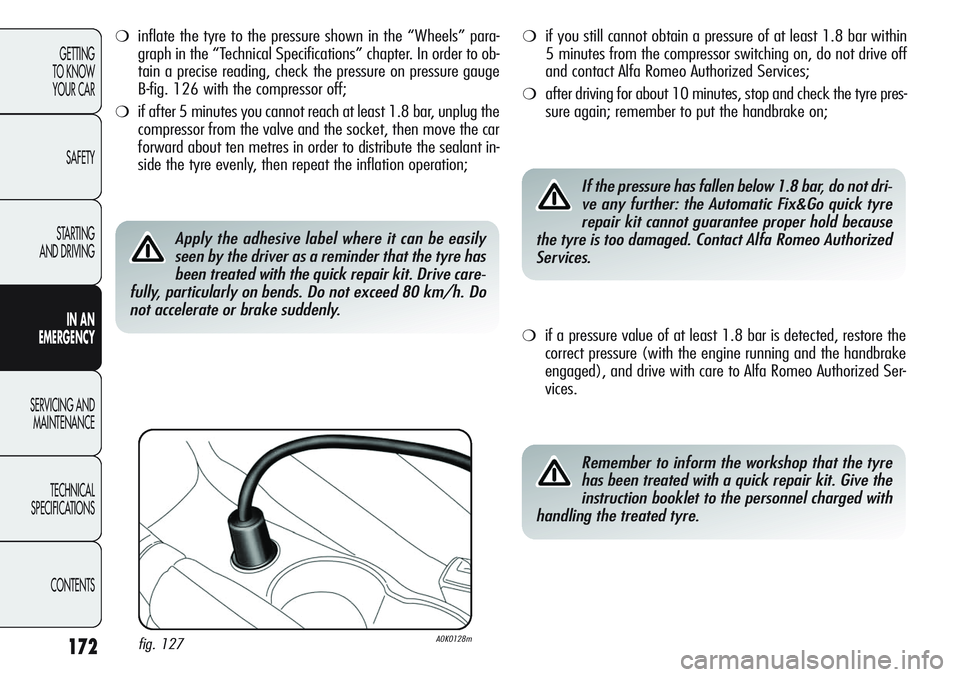
172
GETTING
TO KNOW
YOUR CAR
SAFETY
STARTING
AND DRIVING
IN AN
EMERGENCY
SERVICING AND
MAINTENANCE
TECHNICAL
SPECIFICATIONS
CONTENTS
❍inflate the tyre to the pressure shown in the “Wheels” para-
graph in the “Technical Specifications” chapter. In order to ob-
tain a precise reading, check the pressure on pressure gauge
B-fig. 126 with the compressor off;
❍if after 5 minutes you cannot reach at least 1.8 bar, unplug the
compressor from the valve and the socket, then move the car
forward about ten metres in order to distribute the sealant in-
side the tyre evenly, then repeat the inflation operation;
❍if you still cannot obtain a pressure of at least 1.8 bar within
5 minutes from the compressor switching on, do not drive off
and contact Alfa Romeo Authorized Services;
❍after driving for about 10 minutes, stop and check the tyre pres-
sure again; remember to put the handbrake on;
Apply the adhesive label where it can be easily
seen by the driver as a reminder that the tyre has
been treated with the quick repair kit. Drive care-
fully, particularly on bends. Do not exceed 80 km/h. Do
not accelerate or brake suddenly.
❍if a pressure value of at least 1.8 bar is detected, restore the
correct pressure (with the engine running and the handbrake
engaged), and drive with care to Alfa Romeo Authorized Ser-
vices.
If the pressure has fallen below 1.8 bar, do not dri-
ve any further: the Automatic Fix&Go quick tyre
repair kit cannot guarantee proper hold because
the tyre is too damaged. Contact Alfa Romeo Authorized
Services.
Remember to inform the workshop that the tyre
has been treated with a quick repair kit. Give the
instruction booklet to the personnel charged with
handling the treated tyre.
fig. 127A0K0128m
Page 197 of 297

20
20
20
5
5
7.5
15
15
20
15
15
15
15
15
5
7.5155
155
155
155
155
155
157
157
157
157
157
157
153
153
153
153
193
GETTING
TO KNOW
YOUR CAR
SAFETY
STARTING
AND DRIVING
IN AN
EMERGENCY
SERVICING AND
MAINTENANCE
TECHNICAL
SPECIFICATIONS
CONTENTS
F43
F47
F48
F49
F51
F53
F60
F61
F62
F63
F64
F65
F85
F86
F87
F88
USERS FUSE AMPS FIGURE
Two-way windscreen washer pump
Front electric window (driver side)
Front electric window (passenger side)
Various devices
Various devices
+30
Lumbar adjustments
Front seat heater
BOSE amplifier + Subwoofer
Left front seat movement
Right front seat movement
Electric sunroof
Cigar lighter/power socket
12V boot power socket
IBS Battery charge status sensor for Start&Stop system
External mirror defrosters
Page 201 of 297
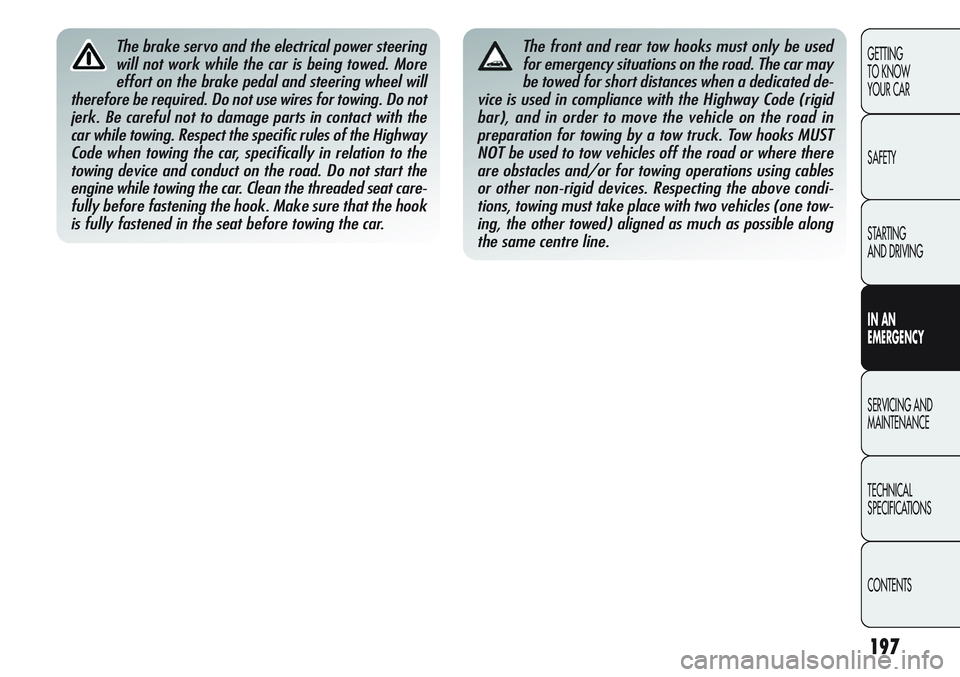
197
GETTING
TO KNOW
YOUR CAR
SAFETY
STARTING
AND DRIVING
IN AN
EMERGENCY
SERVICING AND
MAINTENANCE
TECHNICAL
SPECIFICATIONS
CONTENTS
The brake servo and the electrical power steering
will not work while the car is being towed. More
effort on the brake pedal and steering wheel will
therefore be required. Do not use wires for towing. Do not
jerk. Be careful not to damage parts in contact with the
car while towing. Respect the specific rules of the Highway
Code when towing the car, specifically in relation to the
towing device and conduct on the road. Do not start the
engine while towing the car. Clean the threaded seat care-
fully before fastening the hook. Make sure that the hook
is fully fastened in the seat before towing the car.The front and rear tow hooks must only be used
for emergency situations on the road. The car may
be towed for short distances when a dedicated de-
vice is used in compliance with the Highway Code (rigid
bar), and in order to move the vehicle on the road in
preparation for towing by a tow truck. Tow hooks MUST
NOT be used to tow vehicles off the road or where there
are obstacles and/or for towing operations using cables
or other non-rigid devices. Respecting the above condi-
tions, towing must take place with two vehicles (one tow-
ing, the other towed) aligned as much as possible along
the same centre line.
Page 220 of 297
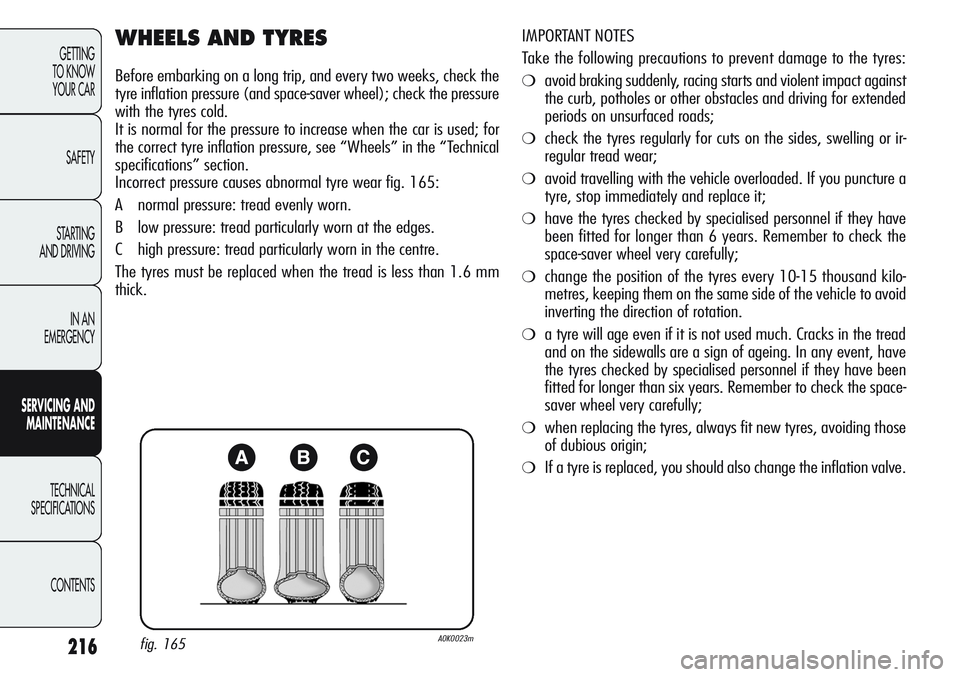
216
GETTING
TO KNOW
YOUR CAR
SAFETY
STARTING
AND DRIVING
IN AN
EMERGENCY
SERVICING AND
MAINTENANCE
TECHNICAL
SPECIFICATIONS
CONTENTS
WHEELS AND TYRES
Before embarking on a long trip, and every two weeks, check the
tyre inflation pressure (and space-saver wheel); check the pressure
with the tyres cold.
It is normal for the pressure to increase when the car is used; for
the correct tyre inflation pressure, see “Wheels” in the “Technical
specifications” section.
Incorrect pressure causes abnormal tyre wear fig. 165:
A normal pressure: tread evenly worn.
B low pressure: tread particularly worn at the edges.
C high pressure: tread particularly worn in the centre.
The tyres must be replaced when the tread is less than 1.6 mm
thick.IMPORTANT NOTES
Take the following precautions to prevent damage to the tyres: ❍avoid braking suddenly, racing starts and violent impact against
the curb, potholes or other obstacles and driving for extended
periods on unsurfaced roads;
❍check the tyres regularly for cuts on the sides, swelling or ir-
regular tread wear;
❍avoid travelling with the vehicle overloaded. If you puncture a
tyre, stop immediately and replace it;
❍have the tyres checked by specialised personnel if they have
been fitted for longer than 6 years. Remember to check the
space-saver wheel very carefully;
❍change the position of the tyres every 10-15 thousand kilo-
metres, keeping them on the same side of the vehicle to avoid
inverting the direction of rotation.
❍a tyre will age even if it is not used much. Cracks in the tread
and on the sidewalls are a sign of ageing. In any event, have
the tyres checked by specialised personnel if they have been
fitted for longer than six years. Remember to check the space-
saver wheel very carefully;
❍when replacing the tyres, always fit new tyres, avoiding those
of dubious origin;
❍If a tyre is replaced, you should also change the inflation valve.
fig. 165A0K0023m
Page 235 of 297
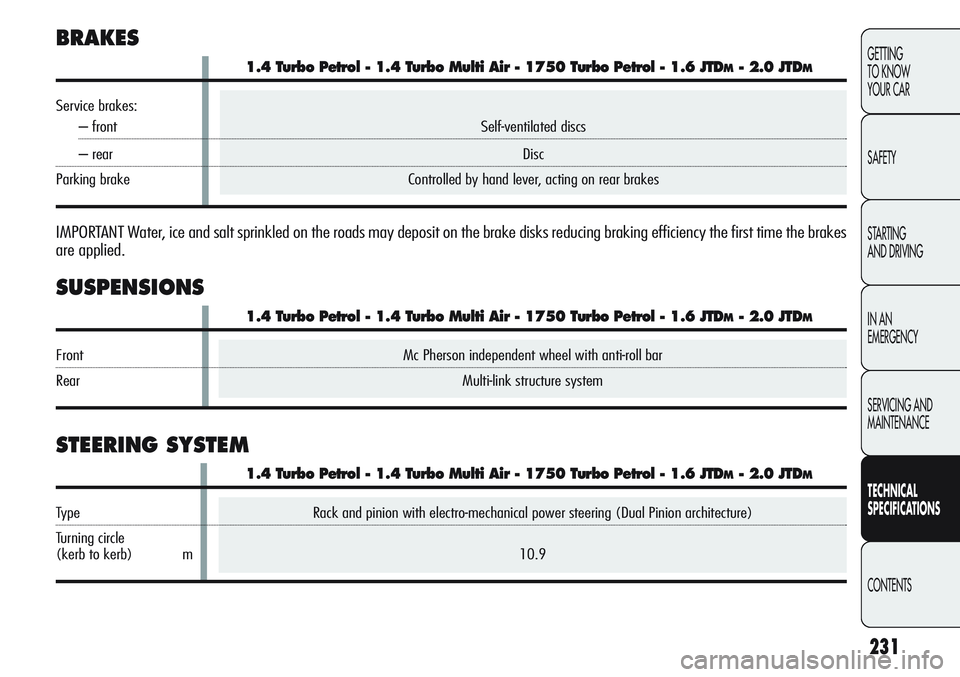
Rack and pinion with electro-mechanical power steering (Dual Pinion architecture)
10.9
231
GETTING
TO KNOW
YOUR CAR
SAFETY
STARTING
AND DRIVING
IN AN
EMERGENCY
SERVICING AND
MAINTENANCE
TECHNICAL
SPECIFICATIONS
CONTENTS
Mc Pherson independent wheel with anti-roll bar
Multi-link structure system
STEERING SYSTEM
Self-ventilated discs
Disc
Controlled by hand lever, acting on rear brakes
BRAKES
IMPORTANT Water, ice and salt sprinkled on the roads may deposit on the brake disks reducing braking efficiency the first time the brakes
are applied.
SUSPENSIONS
1.4 Turbo Petrol - 1.4 Turbo Multi Air - 1750 Turbo Petrol - 1.6 JTDM- 2.0 JTDM
Service brakes:
– front
– rear
Parking brake
1.4 Turbo Petrol - 1.4 Turbo Multi Air - 1750 Turbo Petrol - 1.6 JTDM- 2.0 JTDM
Front
Rear
1.4 Turbo Petrol - 1.4 Turbo Multi Air - 1750 Turbo Petrol - 1.6 JTDM- 2.0 JTDM
Type
Turning circle
(kerb to kerb) m